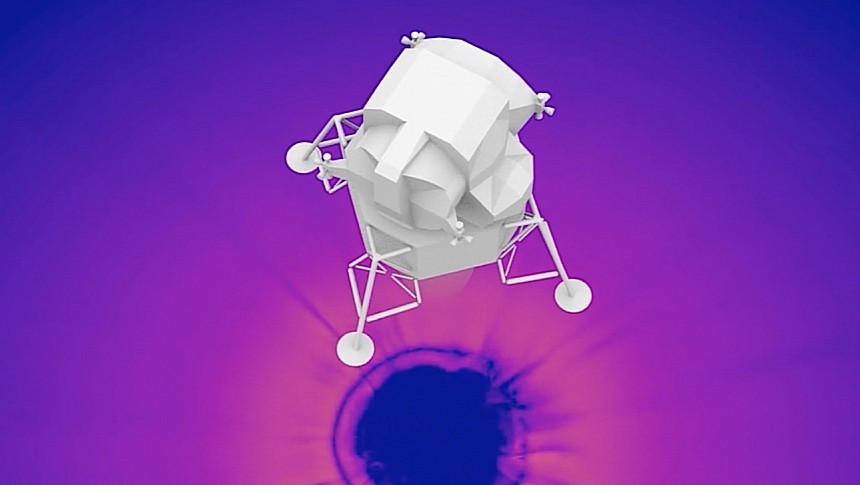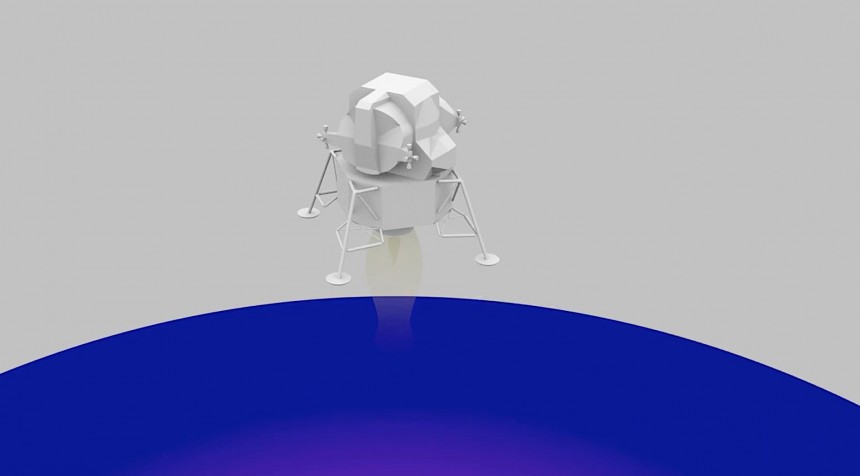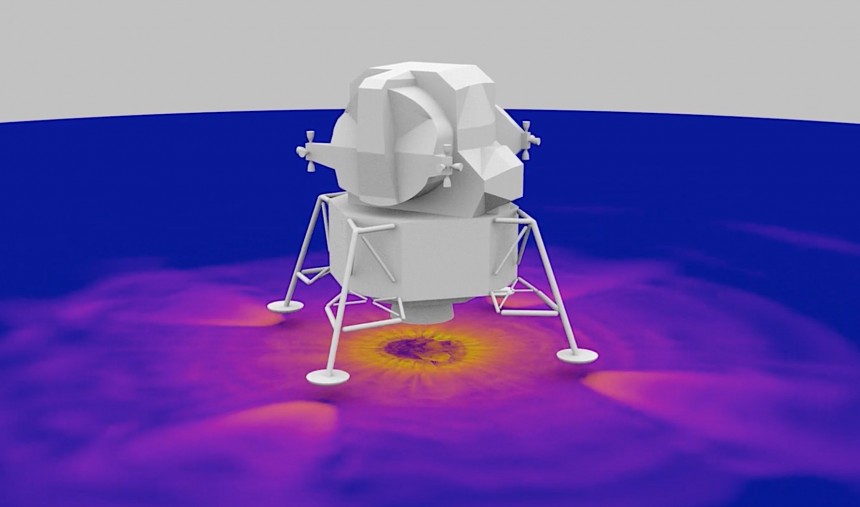
Photo: Patrick Moran/NASA Ames Research Center/Andrew Weaver/NASA Marshall Space Flight Center
Apollo 12 was the second Moon landing mission performed by NASA. It unfolded successfully in 1969, placing the feet of Pete Conrad and Alan Bean on the lunar surface. And now the mission can help inform the upcoming landings of the Artemis program.
Now perhaps more than ever NASA is growing increasingly concerned with what may happen when the rocket plumes of the Artemis lunar landers (including the SpaceX Starship Human Landing System and the ones meant to send supplies up there under the Commercial Lunar Payload Services) may have on the surface of the Moon.
The concern is not necessarily related to the well-being of our planet's celestial companion, but to the fact the scorching, fast-flowing exhaust of the rockets may have unwanted, potentially dangerous effects on the landing spacecraft.
You see, during the Apollo missions there was no significant damage caused by landings. That means there were no craters resulting from the spacecraft's descent, although there were other, less dangerous effects recorded.
The Artemis landers, on the other hand, will be larger than Apollo's and, more importantly, they will use more potent rockets for descent and touchdown. That means they pose significantly higher risks than the hardware of the 1960s and 1970s.
As per NASA, it is unknown at this point how much they will "erode the surface and whether they will rapidly cause cratering in the landing zone."
Why is this important? Well, a cratered landing zone may pose significant dangers to the lander, as it could touch down in another position than planned, or will have its stability affected by the uneven surface underneath.
When a spacecraft lands, not only on the Moon but everywhere, it causes far more disturbance than potential craters. The supersonic, super-hot rocket plumes coming out of the rocket nozzles also kick up a lot of dust (in the case of the Moon regolith) and, at times, are powerful enough to lift and throw rocks..
We can easily imagine how this can affect the crew's ability to spot dangers and obstacles behind the clouds of dust and debris, or how it might even get in the way of the proper functioning of navigation and science instrumentation. In extreme cases, astronauts might even get physical damage to their spaceship or, if there are any, nearby structures.
There is little NASA can do to predict what will happen when the Artemis landers reach the Moon, because there is no way it can properly replicate the conditions on the Moon here on Earth: low gravity, no atmosphere, and a surface unlike any other that we know of in the solar system.
Well, NASA can't replicate that physically, as there is little computers of our time can't dream of in their world of ones and zeroes.
To get a sense of what Artemis landings would mean for the surface of the Moon, people over at NASA's Marshall Space Flight Center in Huntsville, Alabama have developed "new software tools" to predict stuff like cratering and visual obscuration.
Using the new software and the mighty Pleiades supercomputer – a distributed-memory monster with 228,572 CPU cores and 921 TB of memory – NASA is now using a simulated Apollo 12 lander in the virtual world to learn more on the topic.
You can see part of that work in the short video of the simulation the American space agency released this week. It looks quite crappy, like something a noob would do during their first programming classes, but the sim actually hides a lot of important data rocket scientists can look at.
What we're seeing is a sim of how the engine plumes of the Apollo 12 interact with the lunar surface during the last half-minute of descent, right before the engines cut off. The images hide data on how the forces of the plume interact with the flat computational surface.
More specifically we're looking at something called shear stress, which is the amount of lateral force applied to a set area. Shear stress is the main cause of erosion that takes place when fluids (and plumes are just that) flow over a surface.
In the short, 30-second video, the areas with low shear stress appear in dark purple, while those subjected to a lot of it show up in yellow. It's instantly obvious that the force is the highest directly under the rocket.
We're told the data scientists got from this sim is closely matched what happened on the Moon during the actual Apollo 12 landing. That makes the agency confident it can use such technologies to at least get an idea of what will happen during Artemis landings on the Moon, but potentially even during the upcoming missions to Mars.
And there's a lot of info to go through, because despite the unappealing look of the video shown here, terabytes of data were generated by Pleiades for the program.
It's unclear if any of the findings will be applied to the Starship HLS, which is set to descend on the Moon with humans onboard in 2025.
The concern is not necessarily related to the well-being of our planet's celestial companion, but to the fact the scorching, fast-flowing exhaust of the rockets may have unwanted, potentially dangerous effects on the landing spacecraft.
You see, during the Apollo missions there was no significant damage caused by landings. That means there were no craters resulting from the spacecraft's descent, although there were other, less dangerous effects recorded.
The Artemis landers, on the other hand, will be larger than Apollo's and, more importantly, they will use more potent rockets for descent and touchdown. That means they pose significantly higher risks than the hardware of the 1960s and 1970s.
As per NASA, it is unknown at this point how much they will "erode the surface and whether they will rapidly cause cratering in the landing zone."
Why is this important? Well, a cratered landing zone may pose significant dangers to the lander, as it could touch down in another position than planned, or will have its stability affected by the uneven surface underneath.
We can easily imagine how this can affect the crew's ability to spot dangers and obstacles behind the clouds of dust and debris, or how it might even get in the way of the proper functioning of navigation and science instrumentation. In extreme cases, astronauts might even get physical damage to their spaceship or, if there are any, nearby structures.
There is little NASA can do to predict what will happen when the Artemis landers reach the Moon, because there is no way it can properly replicate the conditions on the Moon here on Earth: low gravity, no atmosphere, and a surface unlike any other that we know of in the solar system.
Well, NASA can't replicate that physically, as there is little computers of our time can't dream of in their world of ones and zeroes.
To get a sense of what Artemis landings would mean for the surface of the Moon, people over at NASA's Marshall Space Flight Center in Huntsville, Alabama have developed "new software tools" to predict stuff like cratering and visual obscuration.
Using the new software and the mighty Pleiades supercomputer – a distributed-memory monster with 228,572 CPU cores and 921 TB of memory – NASA is now using a simulated Apollo 12 lander in the virtual world to learn more on the topic.
What we're seeing is a sim of how the engine plumes of the Apollo 12 interact with the lunar surface during the last half-minute of descent, right before the engines cut off. The images hide data on how the forces of the plume interact with the flat computational surface.
More specifically we're looking at something called shear stress, which is the amount of lateral force applied to a set area. Shear stress is the main cause of erosion that takes place when fluids (and plumes are just that) flow over a surface.
In the short, 30-second video, the areas with low shear stress appear in dark purple, while those subjected to a lot of it show up in yellow. It's instantly obvious that the force is the highest directly under the rocket.
We're told the data scientists got from this sim is closely matched what happened on the Moon during the actual Apollo 12 landing. That makes the agency confident it can use such technologies to at least get an idea of what will happen during Artemis landings on the Moon, but potentially even during the upcoming missions to Mars.
And there's a lot of info to go through, because despite the unappealing look of the video shown here, terabytes of data were generated by Pleiades for the program.
It's unclear if any of the findings will be applied to the Starship HLS, which is set to descend on the Moon with humans onboard in 2025.








